Delay Techniques for Nipple-Sparing Mastectomy: A Retrospective Review of Outcomes in 47 Patients
Laurel K. Chandler, MD1, Jordan Halsey, MD2, Kevin T. Nini, MD2.
1Harvard Medical School, Boston, MA, USA, 2Rutgers - New Jersey Medical School, Newark, NJ, USA.
BACKGROUND: Nipple-sparing mastectomy (NSM) has become a popular method of oncologic breast surgery, allowing for more natural-appearing reconstructed breasts compared to traditional mastectomy. Ischemic complications involving skin flaps and the nipple-areola complex (NAC) can lead to prosthetic explantation and need for revision. Several papers have been published describing delay techniques in patients planned to undergo NSM. Our goal is to demonstrate outcomes in our patient population who underwent a delay procedure prior to NSM. METHODS: We conducted a retrospective review of patients who underwent a delay procedure. The first stage involved undermining the NAC and mastectomy skin flap. At this time, a retroareolar biopsy was performed and, in some cases, a sentinel lymph node biopsy. Subsequently, patients underwent nipple-sparing mastectomy. Patient data including age, comorbidities, breast scars, smoking, delay characteristics, and any complications were recorded. RESULTS: Forty-seven patients (88 breasts) were included in the study. Forty-two cases involved implant-based reconstruction, the other five patients underwent breast reconstruction with a latissimus flap and implant. The average age was 48 (range: 30-64). Half of the mastectomies were performed on biopsy-positive breast cancer, the other 44 mastectomies were performed prophylactically. Eight patients were BRCA positive. The average time between delay and NSM was 15.7 days. Three patients had a positive retroareolar biopsy and underwent traditional mastectomy. Mean time of follow-up was 18 months; all patients reviewed had at least six month follow-up. Two patients had areas of nipple necrosis that resolved without reoperation, while four cases of skin necrosis required re-operation. In these patients, three had previous breast surgery and one patient was a smoker. The overall ischemic complication rate was 6.8%. CONCLUSIONS: A two-stage approach to NSM can reduce risk of skin and NAC necrosis, while allowing for retroareolar and sentinel lymph node biopsies to be performed. This is especially important for patients at high risk for ischemic complications. 
Back to 2018 Posters




